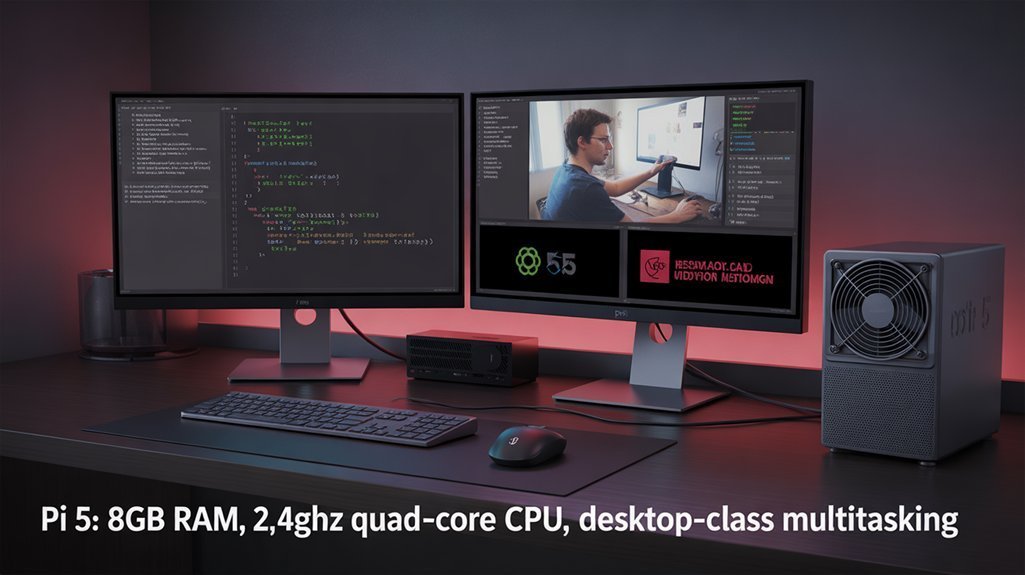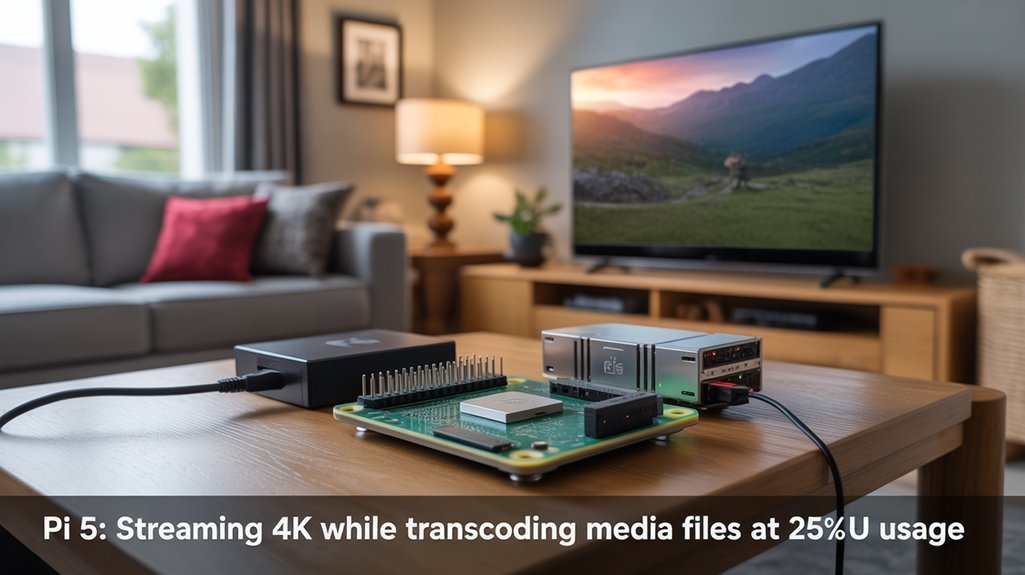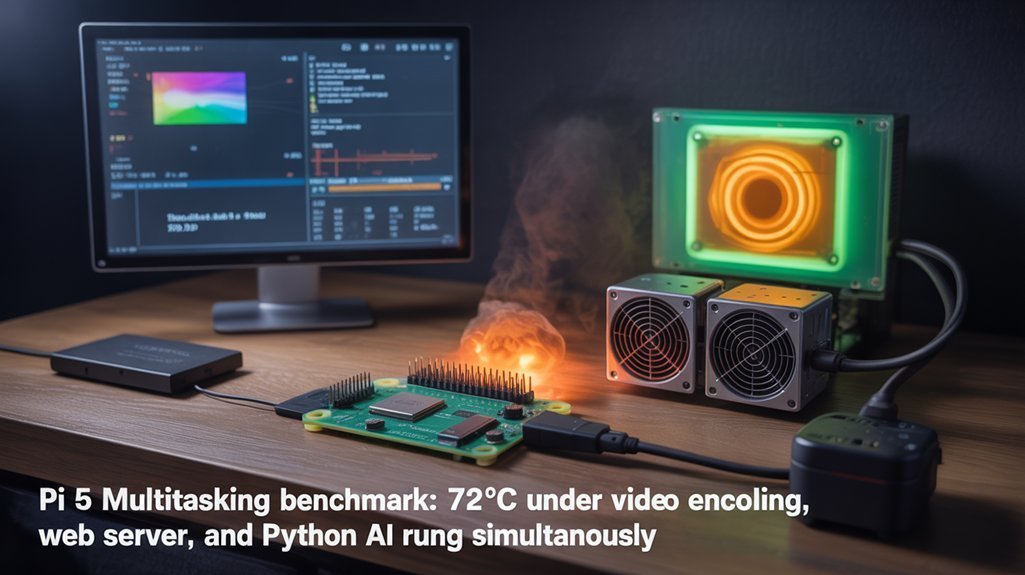You’ve probably wondered how far you can push the limits of Raspberry Pi 5 multitasking. With its quad-core Arm Cortex-A76 CPU and 8GB LPDDR5 memory, it’s not just marginally better than previous models—it’s a dramatic leap forward. You can now compile code nearly three times faster while keeping dozens of browser tabs open, run multiple virtual machines, or stream media while processing IoT data. The question isn’t whether it can handle your workload, but how many tasks you’ll throw at it simultaneously.
Key Takeaways
- Raspberry Pi 5’s quad-core ARM Cortex-A76 CPU delivers 2-3x performance increase over Pi 4, handling multiple applications simultaneously.
- With 8GB LPDDR5 memory and 8,500 Mbps transfer speeds, it manages 40+ browser tabs and complex multitasking workflows.
- The system excels at multimedia tasks, supporting multiple HD streams while performing background operations without lag.
- Enhanced virtualization allows allocation of up to 8 CPU cores for VMs and containers, with Java VMs showing 3.8x performance gains.
- Proper active cooling prevents thermal throttling, maintaining consistent performance during resource-intensive multitasking sessions.
Quad-Core Performance: Running Multiple Applications Simultaneously
When you’re looking to push the boundaries of single-board computing, the Raspberry Pi 5‘s quad-core Arm Cortex-A76 CPU delivers unprecedented multitasking capabilities. Clocked at 2.4 GHz, this powerhouse offers 2-3 times the performance of its predecessor across both single and multi-core operations.
The Pi 5’s application efficiency shines when running multiple programs simultaneously. With Geekbench 6 multi-core scores around 1600, you’ll experience smoother web browsing, video processing, and server tasks through intelligent workload distribution across all four cores. Overclocking the CPU to 3.0GHz can further enhance single-core performance by ×1.2 increase, though multi-core gains remain modest due to memory bandwidth limitations. Additionally, the Raspberry Pi Foundation has designed the Pi 5 to provide strong software compatibility with various operating systems.
Intelligent workload balancing across all cores brings professional-level multitasking to this compact computing marvel.
Each core supports simultaneous threads, dramatically improving responsiveness when juggling complex workflows. You can now confidently run coding environments alongside media playback or maintain multiple browser tabs while handling background processes—all without the lag that plagued previous models. The Pi 5’s vastly improved memory performance achieving nearly 30,000 MB/s in read/write operations makes these multitasking scenarios significantly more fluid.
The improved architecture also supports dual 4Kp60 displays for expanded visual workspaces.
Memory Architecture: How 8GB LPDDR5 Transforms Multitasking
At the heart of the Raspberry Pi 5’s revolutionary multitasking capabilities lies its upgraded 8GB LPDDR5 memory architecture, delivering transformative performance improvements over previous generations. You’ll experience markedly reduced memory bottlenecks thanks to the new unified memory architecture that dynamically allocates resources between CPU and GPU. The enhanced design effectively supports resource-intensive applications and makes complex workloads more manageable. Project compilation times are reduced through the faster memory bandwidth of the LPDDR5 system. Additionally, the lightweight LXDE-based interface ensures that system resources are conserved, further enhancing multitasking efficiency.
| Feature | Multitasking Benefit |
|---|---|
| LPDDR5 Technology | 8,500 Mbps transfer speeds |
| Unified Memory | Real-time resource allocation |
| New Memory Controller | Reduced latency for heavy tasks |
| 8GB Capacity | Simultaneous complex workloads |
This upgraded memory subsystem means you can now run multiple containerized services, process high-resolution media, and manage complex development environments simultaneously. The sophisticated resource allocation system adjusts dynamically to your workflow demands, making the Pi 5 incredibly versatile for developers and makers alike.
Desktop-Class Experience: From Code Compilation to Video Editing

You’ll experience true desktop-class multitasking on the Pi 5, where you can run multiple development environments while the system compiles code 2.8 times faster than its predecessor.
Your multimedia projects benefit from improved CPU and GPU capabilities, allowing smooth 1080p and basic 4K video editing that was previously impossible on earlier Pi generations. Additionally, the quad-core processor of the Raspberry Pi 5 enhances multitasking efficiency for various applications.
With proper cooling to prevent the 20% performance dip from thermal throttling, you can simultaneously manage compilation tasks and media processing without the lag or resource contention that plagued previous Pi versions. The benchmark results demonstrated that Raspberry Pi 5 offers significantly better efficiency for handling performance-sensitive workloads compared to the Pi 4. The Cortex-A76 CPU operating at 2.4 GHz provides substantially improved processing power for demanding applications.
Simultaneous Dev Environments
The Raspberry Pi 5‘s markedly improved hardware transforms it into a capable platform for running multiple development environments simultaneously, providing a desktop-class experience that was previously challenging on older Pi models.
With 8GB or 16GB LPDDR5 memory variants, you’ll enjoy efficient multitasking across various development workloads. The cost-effective IT certification preparation approach allows you to gain hands-on experience with real hardware while utilizing the Pi’s capabilities for diverse projects.
You can leverage remote development through VSCode’s SSH extension, offloading UI rendering to your desktop while executing code on the Pi. This approach optimizes resource usage while maintaining direct access to Pi-specific hardware interfaces. Remote SSH connections provide secure authentication methods that eliminate the need for password entry during frequent development sessions.
Multiple terminal windows, IDEs, and software tools can run concurrently thanks to Linux’s robust multitasking capabilities. The Raspberry Pi’s underlying multi-user operating system enables seamless execution of numerous applications at once. Background services like databases and file servers coexist comfortably with active development sessions, creating a thorough workspace that supports both coding and testing without significant performance degradation.
Fluid Media Processing
While previous Raspberry Pi models struggled with media-intensive workloads, the Pi 5 delivers a remarkably fluid multimedia experience that approaches desktop-class performance. You’ll notice approximately twice the responsiveness in video-related tasks compared to the Pi 4. This new iteration smoothly handles 1080p 60fps playback with minimal video buffering, and even manages 4K content with surprising efficiency. The dual 4K60 HDMI output transforms your workflow possibilities. For video editing, the hardware-accelerated GPU considerably reduces rendering times while optimized codecs lighten CPU load. Additionally, the improved memory bandwidth enhances overall system responsiveness during demanding tasks. Playback optimization is evident through improved memory bandwidth and enhanced display pipelines. For sustained performance during intensive tasks, pair your Pi 5 with passive cooling solutions and stable power supply to prevent thermal throttling during extended editing sessions. The Broadcom BCM2712 CPU with its 2.4GHz quad-core design significantly boosts multitasking capabilities. Real-world applications consistently demonstrate 2-3 fold increases in performance compared to previous Pi models, making complex media tasks more feasible.
IoT Command Center: Managing Dozens of Connected Devices
Leveraging its enhanced CPU and expanded memory capabilities, Raspberry Pi 5 transforms into a powerful IoT command center capable of managing dozens of connected devices simultaneously. You’ll achieve robust IoT device management through multiple communication protocols, while specialized libraries handle command relay operations efficiently. One of the keys to maximizing this performance is implementing remote management options that allow for seamless device control and monitoring.
| Protocol | Use Case | Configuration | Performance | Security |
|---|---|---|---|---|
| SPI | Sensors, ADCs | raspi-config | High-speed | Limited range |
| I2C | EEPROMs, MCUs | raspi-config | Moderate | Address-based |
| MQTT | Remote control | paho-mqtt lib | Lightweight | Encryption support |
| REST API | Smart devices | HTTP requests | Standardized | Token-based |
| GPIO | Direct control | Python/C++ | Real-time | Physical access |
Enable multithreaded Python scripts to process sensor data while dispatching commands across your network. With Home Assistant or Mosquitto MQTT broker, you’ll create automation routines that coordinate dozens of devices without performance degradation. Setting up instant notification systems through Pushbullet or IFTTT allows you to receive real-time alerts from your IoT devices. Since Raspberry Pi 5 lacks native ADC capability, external conversion modules can be easily integrated through SPI or I2C connections to expand analog sensing options.
Media Server Capabilities: Streaming While Processing

You’ll find the Raspberry Pi 5 excels as a media server, handling multiple HD streams to different devices while simultaneously managing background tasks like metadata scraping.
Its improved CPU performance enables enhanced transcoding capabilities, converting your media files on-the-fly for compatibility with various playback devices. With the 40-pin GPIO header, the Raspberry Pi 5 allows for seamless integration with external hardware, enhancing its functionality even further.
When paired with an SSD and proper cooling solution, your Pi 5 can maintain smooth 4K playback even while processing library updates or handling additional streams to secondary devices. The Raspberry Pi 5 can centralize and organize all your multimedia files across your private network, making them accessible from various client devices. Unlike its predecessors, the Pi 5 offers significantly better performance while maintaining the energy efficiency benefits that make Raspberry Pi devices so appealing for 24/7 media server operations.
Multiple Streams Simultaneously
The Raspberry Pi 5’s impressive multitasking architecture enables it to handle multiple media streams simultaneously, transforming this compact device into a powerful home media server.
You’ll enjoy seamless multi-user access with the ability to stream up to four concurrent 1080p videos or even two separate 4K streams without frame drops. Additionally, the Raspberry Pi 5 can efficiently manage power consumption during these tasks, ensuring smooth operation.
For peak performance when video streaming to multiple devices:
- Connect via Gigabit Ethernet rather than Wi-Fi to minimize buffering
- Use a USB 3.0 external SSD for faster data throughput
- Implement active cooling to maintain temperatures around 50°C during heavy loads
Pair your Pi 5 with Plex or Kodi to organize your media library while delivering content to smart TVs, phones, and laptops throughout your home. The 5V/3A power supply guarantees stability even when handling extensive media collections and multiple simultaneous connections.
This affordable $40-$50 solution allows you to create a dedicated Plex server that works perfectly with storage devices like UNAS Pro NAS. Optional overclocking configurations can further enhance performance when streaming multiple high-definition videos simultaneously.
Enhanced Transcoding Performance
While previous Raspberry Pi models struggled with simultaneous transcoding and streaming, the Pi 5 shines with its enhanced processing capabilities that transform this compact board into a legitimate media server powerhouse.
You’ll notice immediate performance gains with the Pi 5 achieving around 24 FPS for software encoding compared to Pi 4’s 9.3 FPS. With CPU utilization at about 80% across all cores, you can implement advanced transcoding strategies while maintaining system responsiveness.
Though Pi 4 currently outperforms in hardware encoding (58 FPS vs 22 FPS), the Pi 5’s superior CPU architecture makes it ideal for software-optimized workflows.
The approximately 2-3x CPU performance boost translates to smoother simultaneous streaming and transcoding of 1080p content. With the new BCM2712 SoC featuring four ARM Cortex-A76 cores, multitasking efficiency reaches new heights for media server applications.
The Pi 5’s benchmark performance of around 30 GigaFLOPS provides sufficient computational power for handling basic transcoding tasks alongside other server operations.
Consider customizing your pipeline by combining hardware acceleration with software optimizations based on your specific codec and quality requirements.
Development Environment: Virtual Machines and Containers
As developers explore virtualization options on the Raspberry Pi 5, they’ll find a considerably more capable platform than previous iterations, with dramatic performance improvements supporting both virtual machines and containers.
You’ll experience up to 18.2x better multi-threading in VM environments compared to Pi 4, making serious development work feasible.
Container orchestration shines with the Pi 5’s enhanced memory bandwidth, enabling you to run multiple microservices simultaneously with lower overhead than virtual machines.
The improved Solid State Drive performance with average read speeds of 400 MB/s provides faster virtual environment deployment and data access.
The four Cortex-A76 cores significantly boost virtualization capabilities while maintaining energy efficiency during development workloads.
For your development workflow, consider:
- Allocating resources from the 8-core CPU and up to 8GB RAM between VMs and containers
- Leveraging GPU acceleration via Vulkan for ML inference tasks
- Running Java VMs with 3.8x performance gains over previous generations
Real-World Multitasking Benchmarks and Thermal Management

Moving beyond virtualization capabilities, let’s examine how the Raspberry Pi 5 performs in real-world scenarios when pushed to its limits.
Real world benchmarks reveal impressive multithreaded performance gains—approximately 1.5× to 2.5× improvement over the Pi 4 across Sysbench, stress-ng, and Geekbench 6 tests.
The Pi 5 delivers substantial muscle where it counts, offering up to 2.5× the multithreaded prowess of its predecessor.
Browser multitasking shows RAM capacity is vital: the 2GB model handles 5-10 tabs adequately but struggles with 40, while the 8GB version manages smoothly. This highlights how memory constraints affect real-world usage more than pure CPU benchmarks suggest.
Thermal efficiency becomes essential with Pi 5’s increased power draw (11.6W vs 4.84W at full load). The $5 active cooler isn’t just an optional accessory—it’s crucial for maintaining performance during sustained workloads, preventing throttling that would otherwise compromise your multitasking capabilities. Proper shutdowns are also important to avoid SD card corruption during intensive tasks.
Frequently Asked Questions
Can Raspberry Pi 5 Run Windows 11 Effectively?
While your Raspberry Pi 5 can run Windows 11, it’s not “effective” due to performance limitations, driver issues, and ARM compatibility constraints. It’s more suitable for experimentation than daily use.
How Does Pi 5 Compare to Entry-Level Intel NUCS?
Contrary to assumptions, performance benchmarks show Pi 5 offers impressive value despite NUCs’ superiority. Your NUC delivers better expandability and raw CPU power, while Pi 5 excels in efficiency and targeted hardware comparisons.
What’s the Power Consumption When Fully Utilizing All Cores?
When fully loading all four cores, your Pi 5 draws approximately 11.6 watts using performance governor. This power consumption reflects improved core performance but lower power efficiency compared to Pi 4’s 4.84 watts.
Can Pi 5 Mine Cryptocurrencies Profitably?
No, you can’t mine cryptocurrencies profitably on your Raspberry Pi 5. Although it can run mining software, you’ll earn only about $0.01 daily after electricity costs—far below specialized ASIC miners.
Does Overclocking Significantly Impact Raspberry Pi 5 Multitasking Stability?
Yes, overclocking greatly impacts your Pi 5’s multitasking stability. While you’ll gain performance benefits, you’ll face increased crashes during intense multitasking unless you carefully tune voltage and implement advanced cooling solutions.
What Have You Learned About Raspberry Pi 5 Multitasking?
Your Raspberry Pi 5 stands as a digital Swiss Army knife, slicing through computational barriers with its quad-core muscle and generous memory pool. You’ll transform this pocket-sized powerhouse into a multitasking maestro, orchestrating virtual machines, development environments, and media streaming simultaneously. The thermal management keeps performance humming even when pushed to its limits. This isn’t just an evolution—it’s a miniature computing revolution in your hands.
